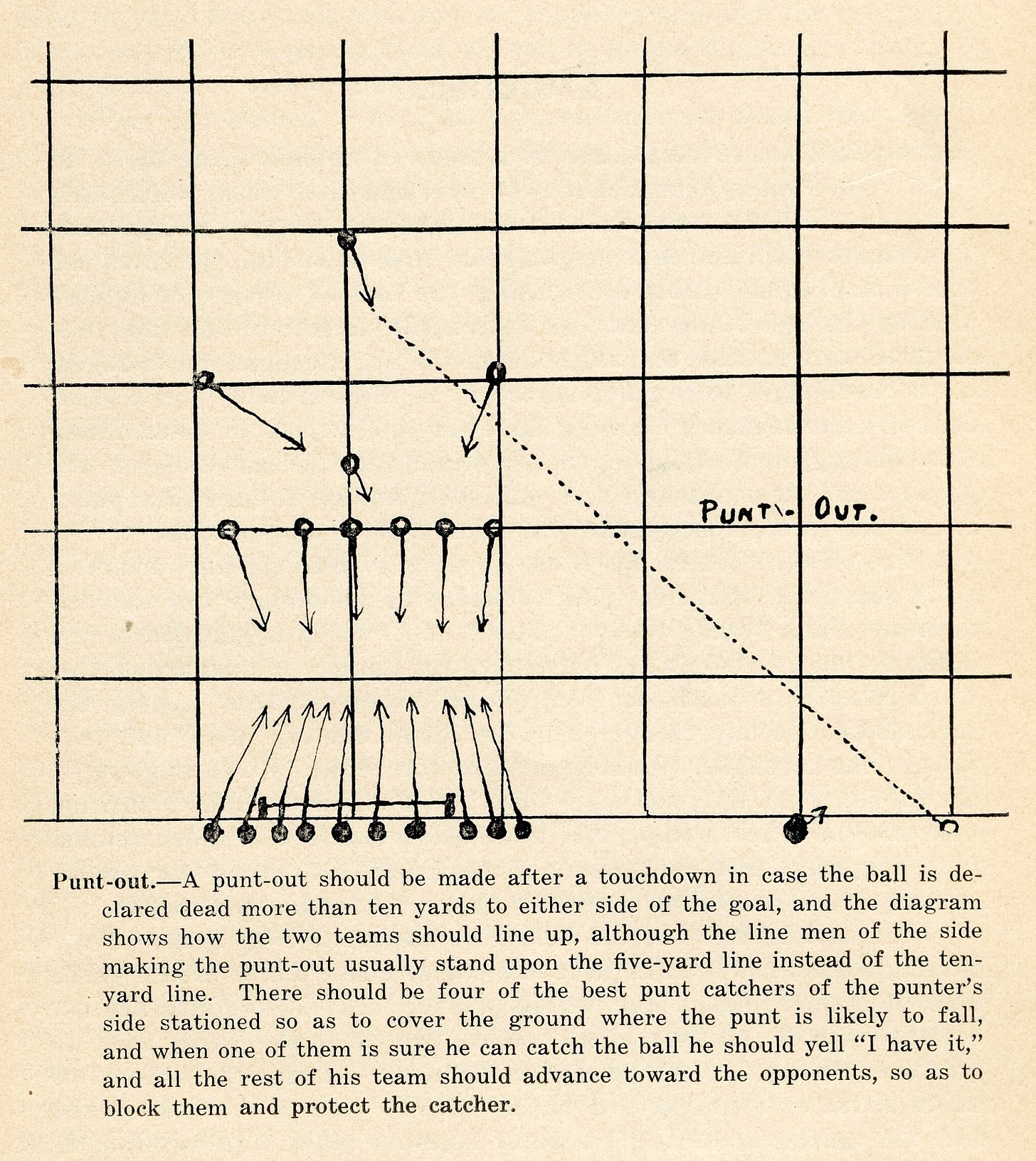Today's Tidbit... 1876 IFA Rule #49: Puntout Spot
This is #49 in a series covering football's original 61 rules adopted by the Intercollegiate Football Association in 1876. We review one rule each Friday.
Rule 49 is another instance in which rugby and football rule makers seemed to list the rules randomly at times. Rule 29 described the puntout by indicating that it occurred from behind the goal line, with the ball being kicked to a player on the playing field. It did not tell us where along or behind the goal line the puntout should occur or what the defensive team was permitted to do during a puntout. Between Rule 29 and 49, there were a few rules related to the puntout, so when I covered Rule 29, I described the entire puntout process, including the portion covered in Rule 49.
Rule 49: If the try at goal be by a punt-out (see Rule 29) a player of the side which has touched the ball down shall bring it straight up to the goal-line opposite to the spot where it was touched down, and there make a mark on the goal-line, and then punt out from the touch-in-goal if necessary, or from any part behind the goal-line not nearer to the goal-post than such mark, beyond which it is not lawful for the opposite side (who must keep behind their goal-line) to pass until the ball has been kicked. (See Rules 54 and 55.)
Having explained the puntout here several months ago, I will not cover it again. Still, I will use the puntout to observe how rugby and gridiron football moved on from one another after they broke up in 1876.
Rugby and football having moved on from one another is analogous to the experience many have had of becoming acquainted with a neighbor or work colleague's children while they are young. If you or they relocate or change jobs, you might not see those children until ten years later, at which point we are surprised they no longer look and act as they did ten years ago. They have grown and changed. Similarly, after gridiron football split from rugby, football changed in many ways, but so did rugby, though less dramatically than the gridiron game.
One of the ways rugby union changed was that it eliminated the puntout in 1883, less than a decade after football began. A version of the puntout returned to rugby in the late 1890s to replace the line-out as the method to bring the ball into play after it went out of bounds. That experiment lasted only a year or so before the puntout was banished for good, while football continued using the puntout until 1920.
Click the appropriate link for previous stories in the series:
Intro | #1 Drop Kick | #2 Place Kick | #3 Punt | #4 Goal Posts | #5 Goal | #6 Goal ≠ Punt | #7 Scoring | #8 Dead Ball | #9 Touchdown | #10 Tackle | #11 Scrimmage | #12 Ball Handling | #13 Dead Ball | #14 Scrimmage Ball Handling | #15 Run In | #16 Goal Line | #17 Boundary Lines | #18 Crying “Down” | #19 Maul In | #20 Maul in Pax | #21 Touch-in Goal | #22 Onside | #23 Offside | #24 Return to Onside | #25 Defensive Offside | #26 Throwing Back | #27 Knocking On | #28 Fair Catch | #29 Punt-out | #30 Punt-On | #31 Into Touch | #32 Inbounding | #33 Pushed Into Touch | #34 Right Angle Throw Out | #35 No Fair Catch | #36 Kickoff | #37 Kickoff Timing | #38 Change Goals | #39 Toss Up | #40 Loser Kicks | #41 Kickout | #42 Kickout Procedure | #43 Fair Catch Free Kick | #44 Free Kick Location | #45 Own Goal Touch Down | #46 Try At Goal | #47 Try At Goal Spot | #48 Touched Down Between Posts
Football Archaeology is reader-supported. Click here to buy one of my books or otherwise support the site.



Bring back the puntout!